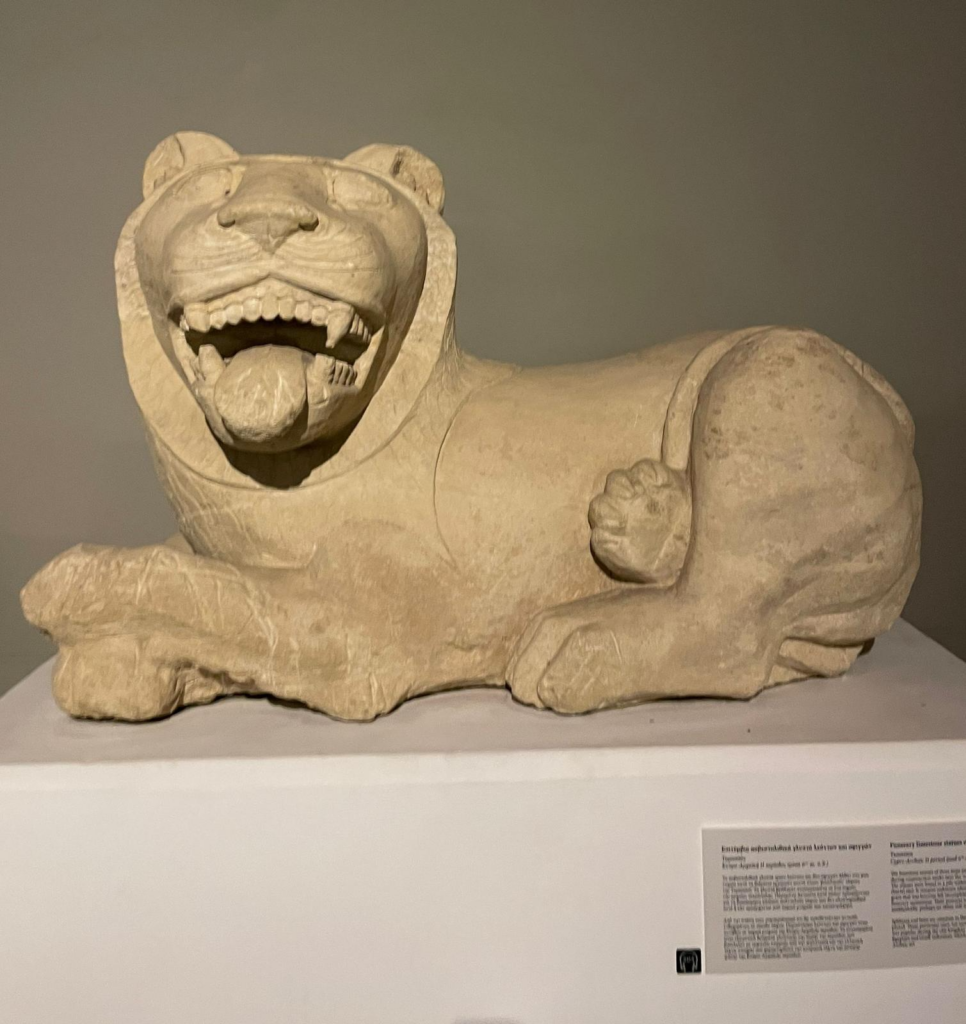Parker Miraldi
Whenever I go to a museum, my favorite thing to look for is depictions of animals that the artist had obviously never seen in real life. There’s something about a bird with a neck that’s too long for its body or a dolphin with too many teeth that fills my heart with joy! Of all the disproportionate animals though, I see lions the most. I’ve noticed this phenomenon before at select museums back in the States, but without fail each one we’ve visited here in Cyprus has had a derpy lion proudly on display. And this made me wonder: why are there so many lions, and why are they all so strange looking?

There are surprisingly few papers on the role of lions in the ancient Cypriot world, or even in the broader ancient Greek, Roman, or Near Eastern worlds, but from piecing the existing research and the role lions play in popular culture today we can pretty safely assume they held an important cultural position. Similar to today, they were revered as powerful, dangerous animals whose strength surpassed that of the average human (I mean, just look at those teeth!). According to inscriptions at the Ulmašītum Temple in modern-day Iraq, the presence of lion sculptures outside a temple or house was meant to inspire both strength and terror, presumably of their aforementioned strength (and again, those teeth). Other inscriptions on the city gates of Tell Ahmar in modern-day Syria tell of two lions that are representative of their wid role in the culture. The first lion is named “Furious storm-demon, whose onslaught is irresistible, feller of the insubordinate, who helps to achieve one’s desires” and the second “Repulser of battle, overwhelmer of the enemy land, who drives out evil, who brings in good” (Watanabe, 2015: 220). On one hand these inscriptions paint the lion as a violent and aggressive creature with close ties to warfare, but on the other they are also seen as harbingers of victory, of the peace and prosperity that flourishes in the aftermath of the battle. It is in this second christening I think we see the lion begin to take the traits we associate it with today: noble, brave, and ultimately willing to sacrifice itself for the greater good. We see this in modern pop culture like the Harry Potter franchise, where a golden lion is the mascot for bravery and loyalty, both of which are repeatedly represented through characters’ willingness to sacrifice their lives for others. These same traits are translated onto those who are capable of and willing to tame or slay a lion, such as lion tamers in circus acts or the biblical story of Daniel and the lions, in which a young man is thrown into a pit of lions as punishment for continuing to practise Christianity but escapes unharmed after God forces their mouths closed as a reward for Daniel’s spiritual strength. Perhaps these traits are the inspiration behind the many lion statues in the ancient Mediterranean world, which typically guarded the graves of royalty or other politically/socially significant figures (Lethaby 1918). Given what we’ve already discussed regarding the symbolism of lions, in this funerary context they were probably meant to convey the bravery of the entombed, the sacrifices they made to free the people from an enemy (or for the greater good in general), or that they possessed the strength and valour needed to overpower such a ferocious enemy.

So, if lions were so revered, why do these sculptures all look like they were made by somebody who had never even seen a drawing of one? Perhaps they were just bad at sculpting, but I prefer to see the reasons as more nuanced. Instead of demeaning the lions, I think the bad anatomy raises them to an almost mythical status. Similar to griffins or dragons, chances are these sculptors truly *had* never seen a lion, and so had to imagine them to the best of their (admittedly limited) ability. I’m sure we could all conjure a half-decent picture of a lion in our heads now if we tried, likely informed by modern media such as Animal Planet or The Lion King. And even if we aren’t capable of sculpting that image perfectly into stone, we can easily recognise when one created by somebody else isn’t quite up to snuff. But instead of mocking their inaccuracies, I think we should celebrate them. These sculptures are wonderful in the purest sense of the word: they reflect both the artist’s and the commissioner’s own wonder about the creatures in question. They may not have known how exactly to capture the lion’s likeness, or even how to represent the noble and ferocious traits they were so awed by, but that didn’t stop them from trying! And I think we can all learn something from that willingness to give it a go without having all the details perfectly in order. After all, these sculptures are still being viewed, talked about, and loved by people thousands of years later, even if some of that conversation is about their anatomical shortcomings.
Works Cited:
Watanabe, C. E. (2015). The Symbolic Role Of Animals In Babylon: A Contextual Approach To The Lion, The Bull And The Mušḫuššu. Iraq, 77, 215–224. doi:10.1017/irq.2015.17
Lethaby, W. R. (1918). Greek Lion Monuments. The Journal of Hellenic Studies, 38, 37–44. doi:10.2307/625674
